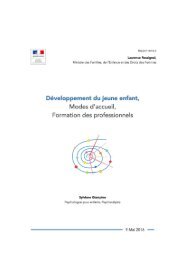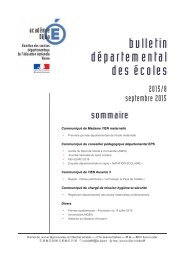agrl_innovations_in_ssa.pdf?utm_content=buffercb41d&utm_medium=social&utm_source=twitter
agrl_innovations_in_ssa.pdf?utm_content=buffercb41d&utm_medium=social&utm_source=twitter
agrl_innovations_in_ssa.pdf?utm_content=buffercb41d&utm_medium=social&utm_source=twitter
Create successful ePaper yourself
Turn your PDF publications into a flip-book with our unique Google optimized e-Paper software.
With regards to research, there is <strong>in</strong>creas<strong>in</strong>g evidence of farmers’ <strong>in</strong>novative capabilities, with<br />
on-farm participatory research play<strong>in</strong>g a key role <strong>in</strong> l<strong>in</strong>k<strong>in</strong>g not only farmers and researchers<br />
but also provid<strong>in</strong>g a focal po<strong>in</strong>t for <strong>in</strong>volvement of other stakeholders <strong>in</strong> the identification of<br />
constra<strong>in</strong>ts, seek<strong>in</strong>g alternative solutions, and the design and evaluation of research results.<br />
This is typified <strong>in</strong> the case studies on the FARA-supported SSA CP PLS <strong>in</strong> Malawi, Nigeria, Niger<br />
and Rwanda IPs.<br />
NGO roles<br />
NGOs have played different roles, sometimes serv<strong>in</strong>g as coord<strong>in</strong>at<strong>in</strong>g bodies <strong>in</strong> promot<strong>in</strong>g<br />
better <strong>in</strong>teraction between public and private organisations, and sometimes <strong>in</strong> assist<strong>in</strong>g farmer<br />
organisations to create self-help groups. However, their major role was <strong>in</strong> support<strong>in</strong>g the<br />
development of networks of farmers and <strong>in</strong> scal<strong>in</strong>g up the use of technologies and market<strong>in</strong>g<br />
practices to other farmers outside the immediate target area of the <strong>in</strong>novation process.<br />
F<strong>in</strong>ancial organisation roles<br />
F<strong>in</strong>anc<strong>in</strong>g organisations did not feature strongly <strong>in</strong> most of the case studies, s<strong>in</strong>ce they<br />
regard credit for smallholder producers as high-risk, compounded by a history of poor credit<br />
repayments. However, a number of rural f<strong>in</strong>anc<strong>in</strong>g <strong>in</strong>stitutions were <strong>in</strong>creas<strong>in</strong>gly enthusiastic<br />
about lend<strong>in</strong>g to small groups of farmers. By far the most important sources of credit were<br />
process<strong>in</strong>g companies to contract growers and <strong>in</strong>put supply companies to agri-dealers.<br />
International stakeholders<br />
International research organisations, <strong>in</strong>ternational NGOs and <strong>in</strong>ternational companies (often<br />
supported by donors) played a key role <strong>in</strong> catalys<strong>in</strong>g coord<strong>in</strong>ation between stakeholders. This<br />
<strong>in</strong>cluded: fund<strong>in</strong>g sector and value-cha<strong>in</strong> studies to identify constra<strong>in</strong>ts and opportunities;<br />
fund<strong>in</strong>g stakeholder meet<strong>in</strong>gs and workshops; together with provid<strong>in</strong>g the <strong>in</strong>itial foundation<br />
for either remedial action or new <strong><strong>in</strong>novations</strong>.<br />
Types and consequences of <strong>in</strong>teraction<br />
The case studies provide examples of many stakeholder <strong>in</strong>teractions public–private and<br />
private–private and as well as those occurr<strong>in</strong>g at regional and <strong>in</strong>ternational levels. The issues<br />
addressed <strong>in</strong> these broad categories of stakeholder <strong>in</strong>teractions are summarised <strong>in</strong> Figure 7<br />
and detailed <strong>in</strong> Annex 3.<br />
The most important issues addressed <strong>in</strong> public–private <strong>in</strong>teractions were the build<strong>in</strong>g of<br />
partnerships, capacity build<strong>in</strong>g and plann<strong>in</strong>g, monitor<strong>in</strong>g, and assess<strong>in</strong>g activities. Private–<br />
private <strong>in</strong>teraction was essential <strong>in</strong> build<strong>in</strong>g farmer organisations and <strong>in</strong> arrang<strong>in</strong>g sales<br />
and contract details. Regional and <strong>in</strong>ternational <strong>in</strong>teractions helped to develop network<strong>in</strong>g<br />
arrangements, trade and health issues <strong>in</strong>clud<strong>in</strong>g FairTrade and organic product registration.<br />
The consequences of these <strong>in</strong>teractions resulted <strong>in</strong> policy and <strong>in</strong>stitutional, economic, support<br />
service, and production outcomes (Figure 8). With<strong>in</strong> policy and <strong>in</strong>stitutional outcomes,<br />
improved <strong>in</strong>teraction between stakeholders, improved cooperation and trust and the formation<br />
A comparative analysis of the case studies<br />
93






